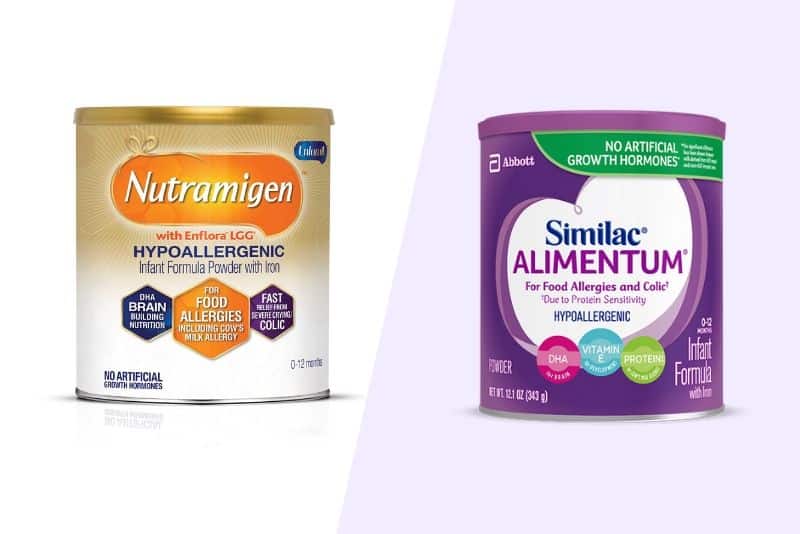When you start the switch from breast milk to formula your baby might experience some acid reflux due to a cow’s milk allergy or they may experience some colic.
This is all perfectly normal and there’s absolutely no need to panic. Thankfully, there are special types of baby formula designed to help, and there are two currently vying for the top spot – also known as the Nutramigen vs Alimentum showdown.
But why exactly do these two help?
It’s because they’re hypoallergenic formulas that pre-digest the milk proteins your baby’s tummy might be having a hard time dealing with.
The reason why it’s a battle between Nutramigen vs Alimentum isn’t because one is better than the other, it’s the fact that they each have their different pros and cons and one formula may sit better with your baby than the other.
Cow’s milk allergy can be a nasty mess to deal with due to the fact that your little one’s body literally cannot stomach certain proteins found in cow’s milk, namely whey and casein.
Symptoms can range from mild to downright hazardous, so do take notice when feeding your child to see if the milk is causing them issues.
The symptoms can be, but aren’t limited to: mild allergic reactions like hives, a rash, or even some swelling to more severe ones like wheezing or a general difficulty breathing for which 911 should be dialed immediately.
We obviously never want to risk the safety of our kids, so it’s best to start treating the issue as soon as possible – allergies are no joke.
Luckily, the allergy is only a temporary one and should pass after about a year if treated properly.
And, while sometimes cow’s milk allergy might come as part of lactose intolerance, the two aren’t the same thing.
Cow’s milk allergy is just that, an allergy caused by a reaction to casein and whey, while lactose intolerance is a reaction to the lactose sugar found in dairy and generally only causes an upset stomach and fussiness.
It won’t pose a threat to a child’s life as much as the allergy might and you can provide a supplement to replace the enzymes that your little one is lacking.
With all that said, let’s break the two products down and see in which cases one should be taken over the other.
Enfamil Nutramigen Hypoallergenic Colic Baby Formula
- Contains 6 - 12.6 ounce cans (total = 75.6 ounces) of hypoallergenic baby formula, lactose and sucrose free milk powder with iron that provides nutrition for the first 12 months
- Enfamil Nutramigen hypoallergenic baby formula delivers clinically-proven relief when managing colic due to cow’s milk allergy for a Happier, better-rested baby & mom
- Fast relief now: as early as the first feeding, with 90% of infants improving within 48 hours fewer allergies in future: specially formulated to reduce the incidence of future allergy challenges by 50%
Prices pulled from the Amazon Product Advertising API on:
Product prices and availability are accurate as of the date/time indicated and are subject to change. Any price and availability information displayed on [relevant Amazon Site(s), as applicable] at the time of purchase will apply to the purchase of this product.
The first one that we’ll be looking at is Enfamil Nutramigen.
It’s dubbed the #1 pediatrician approved infant formula for kids suffering from cow’s milk allergy and for good reason.
This baby formula is jam-packed with loads of healthy nutrients and probiotics to help get your precious child’s immune system back up to snuff and to build their tolerance for whey and casein back up.
This is greatly attributed to the LGG probiotic found within the product as well as the abundance of iron that helps your newborn grow without the need for any artificial growth hormones.
Not to mention the nutrients I touched upon before, which cover all of the essential bases: omega 3 oils, DHA, choline, and ARA – all aimed at helping to stimulate your child’s healthy body and brain development.
This baby formula is essentially a milk formula with all of the problematic parts pre-digested so they can pass through your baby’s digestive system a lot more easily than they would otherwise.
The formula is also both lactose-free and soy-free just in case your child hasany intolerances on top of the cow’s milk allergy.
And they come in the form of baby powder or ready to use bottles if you’re worried about applying the correct dosage per feeding.
The relief this hypoallergenic baby formula provides tends to be quite fast, with results showing within the first two days of use, improving the baby’s gut health and easing their symptoms.
You won’t hear your baby’s tummy rumble anymore and they’ll be a lot less gassy than when they initially contracted this milk allergy.
Spit-ups and acid reflux should disappear altogether.
The allergic reactions themselves should start to fade as well and the milk protein allergy itself should slowly start to clear up over time, with the chances of similar allergies recurring being almost halved.
Though, you ought to get a pediatrician’s opinion to greenlight the swap back to regular baby formula – don’t make the decision on your own.
This should usually be within 6 months to a year of using the formula, give or take a few.
While the formula works great and all, there are some drawbacks to hypoallergenic formulas that both of these hypoallergenic baby formulas share.
They are the taste and the price.
Despite getting about 12 ounces per can and getting 6 cans a pop, the price is rather steep due to the quality of the nutrients used, which unfortunately doesn’t qualify it as a regular use option going forward.
This goes doubly so if you’re a mom on a budget.
Use it for as long as your baby needs it to get the cow’s milk allergy to stop, but swap as soon as possible to keep your wallet from being filled with hot air now instead of your child.
But like I said, the price isn’t the only issue, the taste can be rather strong (as can the smell) which your baby is surely bound to protest, but all good medicine tends to taste rather vile.
We don’t want our kids hating us though, so do make sure to get them something they’ll actually enjoy once the milk allergy period passes.
Pros:
- Pediatrician approved
- Contains crucial nutrients like DHA, ARA, Choline and Omega 3 oils as well as iron
- Contains the LGG probiotic which helps strengthen the baby’s immune system
- Lactose and soy-free
- Results visible within 48 hours
- No artificial growth hormones
Cons:
- Pricey
- Taste and smell are strong due to pre-digested proteins
Similac Alimentum Hypoallergenic Infant Formula
- 4-COUNT VALUE SIZE: Get 4 value-size cans to help make sure you don’t run out; 4 19.8-ounce cans make approximately 143 4-fluid-ounce bottles
- 24-HOUR DIFFERENCE: Our hypoallergenic formula starts reducing excessive crying due to protein sensitivity within 24 hours
- EASY TO DIGEST: Lactose-free formula has broken down proteins that are easier to digest for babies with food allergies. No artificial growth hormones
- MORE VALUE: Sign up for additional benefits and savings on Alimentum by joining Similac StrongMoms Rewards; Get up to Dollar 400 in rewards
Prices pulled from the Amazon Product Advertising API on:
Product prices and availability are accurate as of the date/time indicated and are subject to change. Any price and availability information displayed on [relevant Amazon Site(s), as applicable] at the time of purchase will apply to the purchase of this product.
The other contender in the Nutramigen vs Alimentum matchup, Similac Alimentum is also one of the #1 pediatrician recommended brands out there, placing it in a heated competition with Nutramigen – and the line between them is ever so thin.
It mostly depends on the intended uses.
Speaking of which, this specific baby formula is also helpful for babies who suffer from colic or CMA (cow’s milk allergy) thanks to its hypoallergenic and lactose-free properties.
The formula also contains important nutrients for any growing child to develop in a healthy manner and they are DHA and ARA.
This allows Similac Alimentum to completely supplement other baby formulas during the milk allergy period.
It even contains vitamin E to help with proper eye development, so as far as sight is concerned, your precious bundle of joy can grow up with perfect 20/20 vision.
The formula carries those pesky proteins that cause the allergic reactions in the first place, but again, much like the Enfamil Nutramigen variant, they’re pre-digested and will not cause any issue going down your baby’s digestive tract.
This hypoallergenic baby formula also seems to show results a whole day faster than its competitor, managing to soften the allergic reactions to whey and casein within just 24 hours of ingestion.
This allows your child to calm down and stop crying, leading to a much more peaceful household and a healthier child in turn.
And, much like the competition, it also comes in either powdered or pre-mixed forms.
Thanks to its fast acting properties and the wealth of good nutrients, your baby will manage to sleep better as well, leading to less late night wake-ups from lack of food or from feeling sickly and making a mess in the crib (no more clear or yellow spit-ups on the mattress).
The intended usage period is the first 12 months of the baby’s life as most kids will overcome cow’s milk allergy naturally or will be able to move onto different foods that don’t contain whey or casein.
That said, Similac Alimentum will still be able to accelerate that process, allowing you to swap away from it in a shorter period as your child regains their healthy digestive system back.
One that won’t trouble them on every sip of regular cow’s milk.
Again, much like with the other reviewed formula, don’t decide that on your own and let a medical professional determine whether or not your baby has overcome the allergy in question and given you the thumbs up to stop using Similac Alimentum.
Sadly, it does suffer from similar drawbacks to Enfamil Nutramigen – namely the matter of taste and price.
While you do get a bit more of this one for the purchase price, about 10 or so ounces, it’s still a rather astronomical price to pay for hypoallergenic baby formula.
But given the strong medicinal properties and lack of better substitute, we’re just going to have to deal with it until a cheaper but equally as efficient alternative comes along.
Luckily, they have a ‘StrongMom’ reward system which will at least save you some money when you purchase their products.
Speaking of having to stomach something, again, the taste and smell can be a bit strong (to put it mildly), which might cause your child to refuse it outright.
As soon as they’re done with taking the hypoallergenic baby formula altogether, make sure to reward their taste buds for having to go through it for that long with something extremely tasty but equally healthy.
Pros:
- Pediatrician approved
- Contains DHA and ARA as well as Vitamin E to help improve eyesight
- Said to improve sleep quality in babies
- Visible results within 24 hours
- No artificial growth hormones
- Lactose-free
Cons:
- Pricey
- Taste and smell are unpleasant due to pre-digested proteins
How Do They Compare?
| Image | Title | Price | Prime | Buy |
|---|---|---|---|---|
 | Enfamil Nutramigen Hypoallergenic Colic Baby Formula | Prime | Buy Now | |
 | Similac Alimentum, 4 Count, Hypoallergenic Infant Formula | PrimeEligible | Buy Now |
Now that we’ve looked at the strengths and weaknesses of both baby formulas, one might wonder who wins in the Nutramigen vs Alimentum showdown?
Well, let’s look at the things they have in common first.
Allergic reactions: the Alimentum formula wins
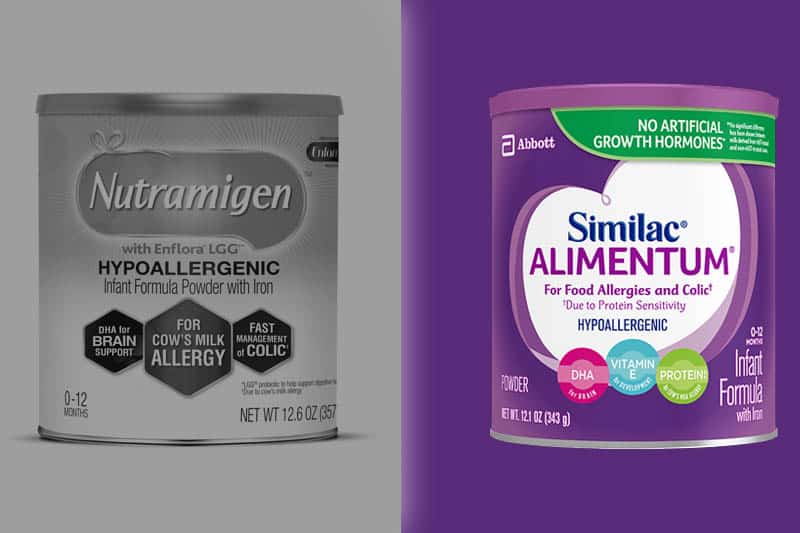
First and foremost, they’re both hypoallergenic baby formulas, meaning that nothing in their composition should be a common allergen.
The only thing that might pose an issue is the corn syrup base of Enfamil Nutramigen, so if your baby has a corn allergy (like my baby did) I suggest that you opt for the other one for this specific reason.
Though, even here, there are some outliers where babies are severely allergic to cow’s milk in general.
So much so that even the hydrolyzed, a.k.a. broken down versions that these hypoallergenic baby formulas contain might cause an unfavorable allergic reaction.
In that case, you might want to look elsewhere – a formula that’s based on amino acids might help out in that case.
Some of the most notable brand names for those are Elecare and Neocate, but this condition is very rare.
Nutritious content: the Nutramigen formula wins
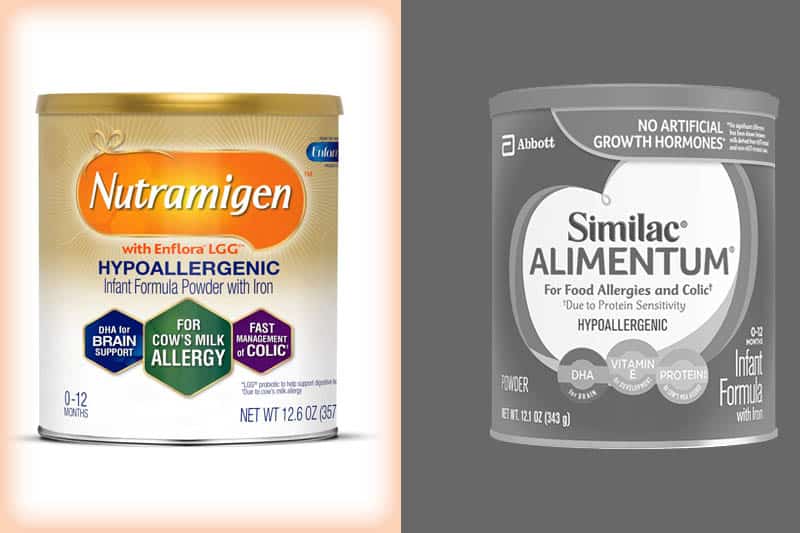
While both have their respective nutrient counts high, Nutramigen also sports a lot of iron which is key in developing a healthy body and to help enrich one’s blood with oxygen.
Not to mention the LGG probiotic that helps strengthen your baby’s immune system to help it overcome it’s cow’s milk allergy a lot faster.
Sure, Alimentum helps with developing better eyesight through the vitamin E it has in its composition, but it’s slightly less important than iron is in a healthy diet.
Regardless, if you’re looking at this category specifically, I’d say pick the one you feel your child could benefit from the most as it’s mostly a matter of opinion.
Fat content: both baby formulas win
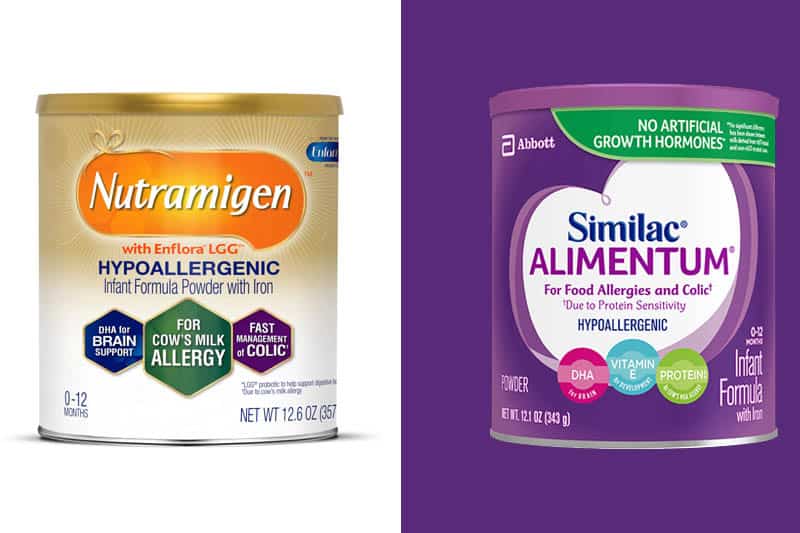
While this isn’t really a big deal when it comes to newborns and babies up to a year old, the fact of the matter is that hypoallergenic formulas tend to put a bit less weight on the baby than standard formulas do.
This means that you won’t really have to worry about your little one putting on a bit too much weight and not fitting into their clothes or shoes.
It may pose an issue if your goal is to specifically try and help your baby gain weight since then you’d have to do a lot more feedings.
But, that shouldn’t be too much of a problem outside of a few extra dollars worth of baby formula or a few extra breastfeeding sessions.
That said, the taste might be the main factor as to why your baby isn’t eating as much. If you’ve ever tried a lick of these formulas, you might lose your appetite too.
Effectiveness: the Alimentum formula wins

This category mostly refers to the amount of time that the beneficial effect needs to kick in and Alimentum manages to inch out ahead by a whole day’s worth.
Mind you, it’s not that big of a deal when put into perspective, but a day less of your baby having to worry about stomach aches and an extra day of peaceful sleep might make all the difference.
Cost: both baby formulas lose
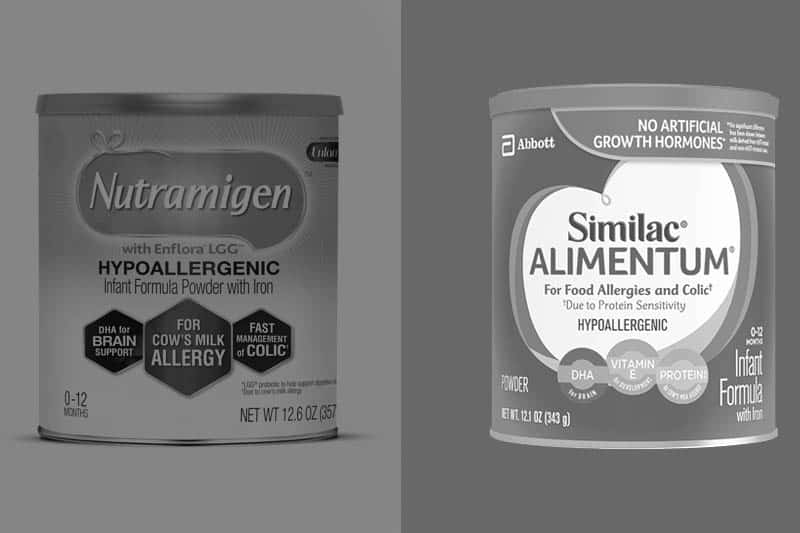
As great as both baby formulas can be, in the battle of Nutramigen vs Alimentum, both sides fall dreadfully short as far as price is concerned, with an average of around 7$ per ounce it’s almost like you’re trying to feed gold dust to your baby.
Moms aren’t made of money and child care costs a whole lot overall.
I do hope that you don’t have to deal with resolving cow’s milk allergy both for the sake of your baby’s health and for the health of your bank balance.
Taste: both baby formulas lose

If the price point left a sour taste in your mouth, you might not want to try the actual product’s flavor.
While babies palates aren’t as evolved as those of adults just yet for them to notice a major difference, it’s most certainly there.
The less than pleasant flavor and smell is mostly due to the hydrolyzed proteins, since anything with the tag “pre-digested” tends to have a rather unpleasant odor to say the least.
Make sure to air the room out after you’re done because you don’t want that smell getting into the furniture or lingering in the air too long or you’ll feel your stomach churn.
Final verdict: The Enfamil Nutramigen formula wins

But, as I had said at the start, it depends on your needs.
Similac Alimentum is safer and it might be better for you if you’re looking for effectiveness in your hypoallergenic baby formula. Or, if your child has an allergic reaction to corn.
Frequently Asked Questions
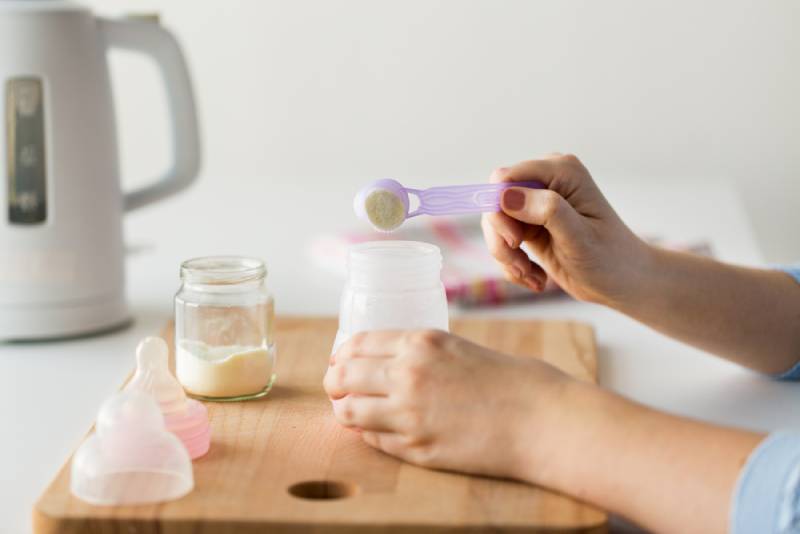
How Do I Swap Back To The Normal Baby Formula Once The Cow’s Milk Allergy Has Been Overcome?
Well, once the allotted period is done and your child’s pediatrician confirms it, what you usually do is you start slowly mixing the two formulas with one another.
This way you get to use up some of that remaining hypoallergenic formula instead of throwing it away while providing an easier (and tastier) transitioning period toward the new one.
It tends to naturally happen once you start introducing solid foods to your precious little one’s diet as well, since then you have no more need for baby formula and you have a bit more variety.
Variety that’s a lot more accessible and a lot cheaper.
Depending on what the pediatrician says, your child may actually have a full on allergy to milk or a lactose intolerance, in which case you should refrain from introducing milk into their diet.
I suggest finding alternatives to the calcium that milk provides in other ingredients like fish.
Once your child reaches the age of 4, you can start reintroducing milk and other dairy products if you get them over the counter enzyme supplements like lactaid and beano, to help digest the lactose that their body normally doesn’t.
Can the two types of formulas be mixed together?
Yes, but only at the very end when your child stops showing symptoms of cow’s milk allergy and you slowly start introducing non pre-digested dairy back into their meal plan as touched upon above.
Use it as a transitioning method when you’re swapping back from the hypoallergenic to the more traditional baby formula.
But, don’t make this decision on your own.
Always consult your child’s pediatrician about whether you can make the step toward reintroducing soy and dairy based baby formulas.
If they approve, then feel free to.
Sure, the hypoallergenic variant is rather hard to swallow due to the taste, but your kid may have gotten used to it and might find it hard to move away from it.
Mixing traditional formula in with the hypoallergenic will help make the process of swapping back a lot easier for both you and them.
What do I do if neither of these two formulas help my child?
While rare, there is a possibility that on top of the regular formula not working out for your child both of the hypoallergenic variants mentioned here won’t either and they might not be able to stomach even the hydrolyzed version of the proteins.
In this case, you’ll need to swap to baby formulas with an amino acid base like Elecare and Neocate in order for your child to be able to digest the food and the nutrients properly.
It is an extreme case, but one that is very real.
Luckily solutions exist thanks to the wonders of the modern age allowing us to deconstruct nutrients to this level.
My baby isn’t gaining as much weight as they should. Is something wrong?
Well, if they don’t have any other medical condition, I can safely say that the difference is in the change of diet. Simple as that.
The initial bout of your baby’s tummy disagreeing with the non-hypoallergenic formula may have caused them to lose some weight as well and they’re slowly gaining it back now.
But, these hypoallergenic variants tend to act as some sort of diet product on their own as babies seem to gain less weight from them than they would from regular baby formula.
When can I stop buying the expensive specialized formula?
The answer to this question entirely depends on the strength of your baby’s immune system and how well it adapts to the initial bout of cow’s milk allergy in the first place.
The usual period is anywhere between 6-12 months, with 12 being the upper limit as at that point your child is going to start consuming more solid foods and having a lot more options other than baby formula.
If they end it sooner, that’s also fantastic as it means you can save some money, but again, that’s something that only your child’s pediatrician can tell you.
Don’t make the decision on your own and consult the relevant healthcare professionals.
Can I ease the monetary burden somehow?
Well, both brands have a “Subscribe & Save” option if you’re buying from Amazon, which will give you a small discount on the price.
Similac Alimentum has a ‘SuperMoms’ program for their products as well.
That might help cut into some of those costs.
Plus, depending on your insurance company, they might be able to cover a portion of the necessary costs for your hypoallergenic formula of choice if sufficient proof of the condition is shown.
They usually chalk it up to a form of medical insurance.
Hopefully, that ends up helping a bit with the already egregious costs of baby maintenance.
In Conclusion
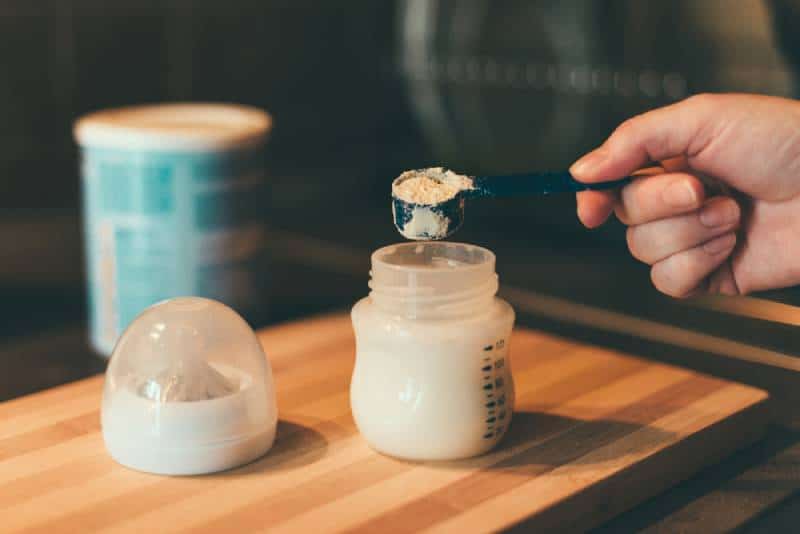
Allergic reactions in babies will always cause scares for us parents no matter how prepared we might be for them, as well as acid reflux and the milder of its brothers, colic, fussiness, and gassy guts.
It’s best to always be prepared and know what you need to do.
Have your pediatrician, doctor, or any other healthcare professional’s number in your phone so you can ask them for advice if an emergency happens.
They’re the ones who will always provide you with the most solid advice and will ensure that your baby struggles as little as necessary to power through any illnesses or allergies.
If allergies are the issue, the pediatrician is going to recommend you get a hypoallergenic baby formula for which there aren’t a lot of good options I’m afraid.
The best ones that I’ve come upon are Enfamil Nutramigen and Similac Alimentum and they’re both amazing at their job, although the prices can be a slight problem due to lack of competition on the market.
But when looking at Nutramigen vs. Alimentum, there really isn’t a universally best formula and it’s all based on subjective opinion, varying from child to child depending on their symptoms.
My personal suggestion is to try one out and see if your child takes to it.
You can go through the first order and if they don’t like it try swapping to the other. If either show results I’d say to stick to it.
Personally, I’d say that Enfamil Nutramigen is the better starter due to the LGG probiotic that it contains which promotes better gut health and is going to save you the hassle of swapping products that might just make your baby fussier.
In the end, it all depends on what your baby likes best (or hates the least) – you can’t go wrong regardless of which one you pick.
I hope your baby’s feeding woes are over quickly and that you’ll soon see your baby smiling more often than crying!
Like this post? Please share or pin it for later. You can also stay in the loop and follow us on Facebook, Instagram or Pinterest.
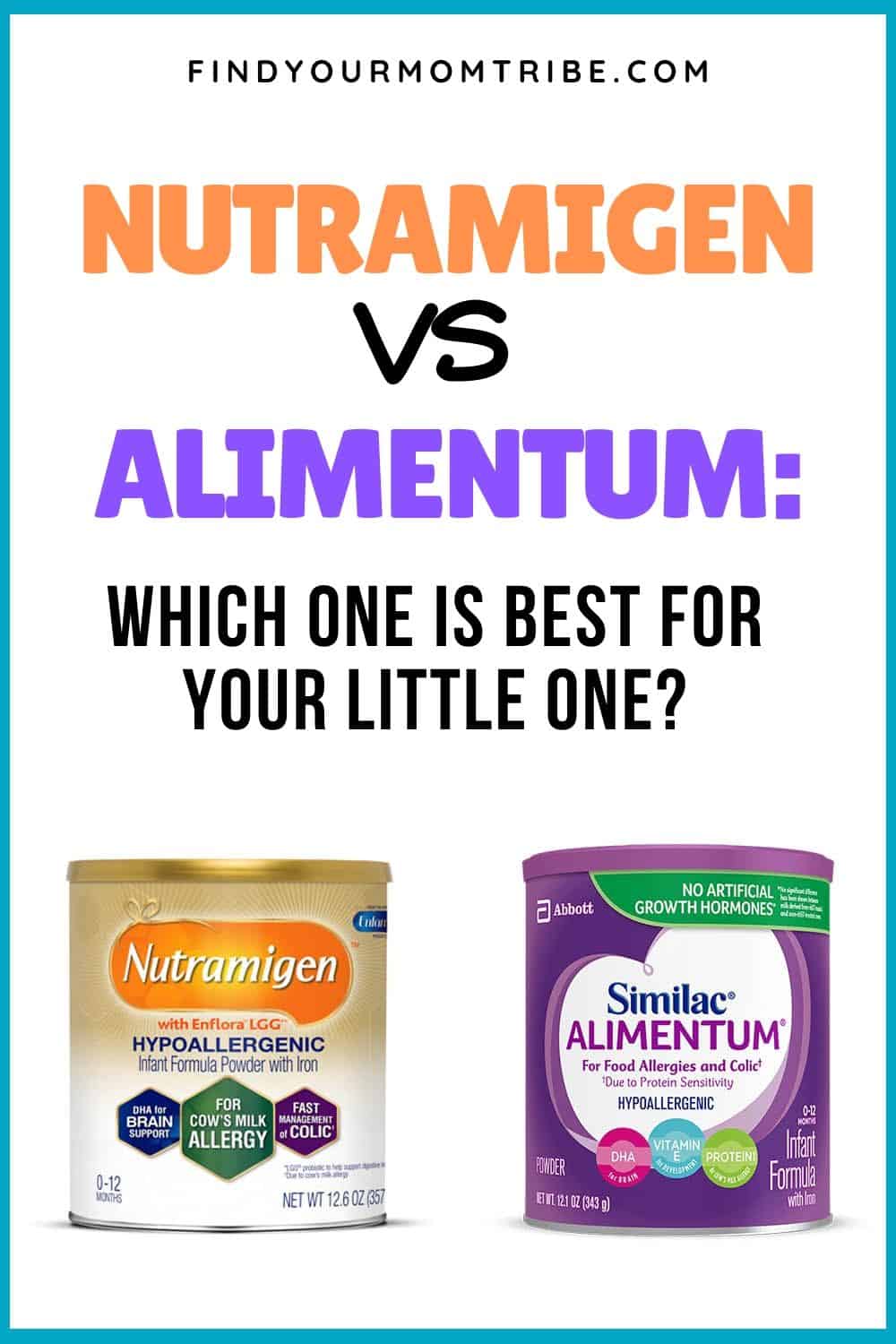
We love honesty! Find Your Mom Tribe is an Amazon Associate and we earn from qualifying purchases through affiliate links at no extra cost to you. Please see our full Amazon Affiliate disclosure for more information.

